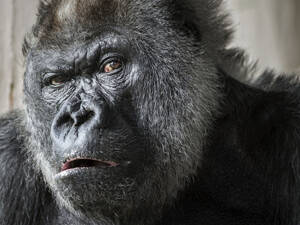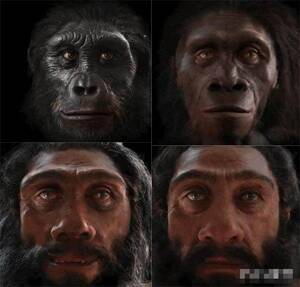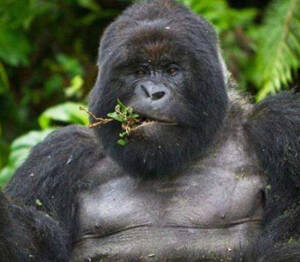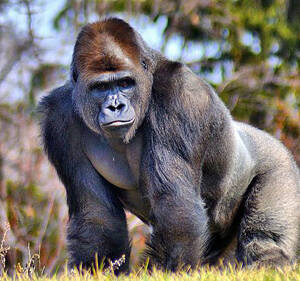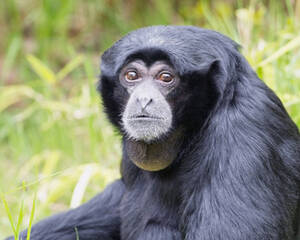Pongo abelii
IUCN
LCBasic Information
Scientific classification
- name:Pongo abelii
- Scientific Name:Pongo abelii,Sumatran Orangutan,Sumatran Orangutan
- Outline:Primates
- Family:Hominidae Orangutan
Vital signs
- length:78-97cm
- Weight:40-90kg
- lifetime:About 45 years
Feature
The largest orangutan in Sumatra
Distribution and Habitat
Distributed in Sumatra, Indonesia.
It lives in lowland tropical rainforests and swamps above 800 meters above sea level, and lives in trees.
Appearance
Female Sumatran orangutans weigh 40-50 kg, males weigh 60-90 kg; females are 78 cm long, males are 97 cm long. They have broad cheeks and a sturdy body. Males can weigh up to 100 kg. This makes it difficult for them to swing between trees, so they can only walk on the ground. They have 12 pairs of ribs, but only 4 lumbar vertebrae; there is a central bone in the wrist, which fuses with the bone behind it as they age. Older ones have long and red whiskers. The thumbs are very small, and the feet are well developed, suitable for grasping objects. The arms are very long, up to 2 meters wide when spread out, and can reach the ankles when standing; the legs are short and not as strong as the arms; the body hair is sparse, dark reddish brown, and the shoulders and back have more than 20 cm long hair; the forehead is prominent, the mouth is prominent, the lips are thin, the eyes, ears, and nose are small, and the distance between the eyes is narrow; the adult male has a leaf-shaped thick fles
Details
The Sumatran orangutan (scientific name: Pongo abelii) is the largest orangutan on the island of Sumatra. Among primates, its size is second only to that of gorillas.
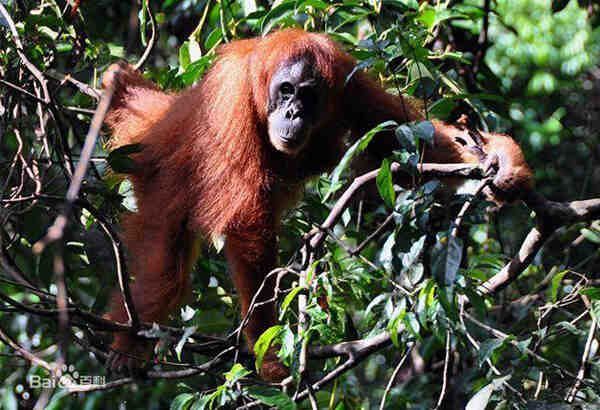
The Sumatran orangutan has a higher IQ than its Bornean cousin, the orangutan, partly because of the large, strong fig trees that allow the species to live in large groups, feed their young together, and socialize and learn from each other. Orangutans have a long life span, and the interval between births for females is 8 years, the longest among all mammals. During this period, mothers can teach their young many survival skills.
The diet of Sumatran orangutans includes a variety of fruits, such as wild figs, which account for a higher proportion than Bornean orangutans. Some of the highly intelligent Sumatran orangutans have learned to use tools, and this knowledge has been passed down through generations of orangutans. They use branches to probe termite mounds to obtain termites for food, and can also obtain larger giant fruits. They also eat leaves, buds, nectar, fruits, branches, bark and bird eggs. Insects and invertebrates are also eaten, but they account for a small amount of their food. Occasionally, they will eat mineral-rich soil.
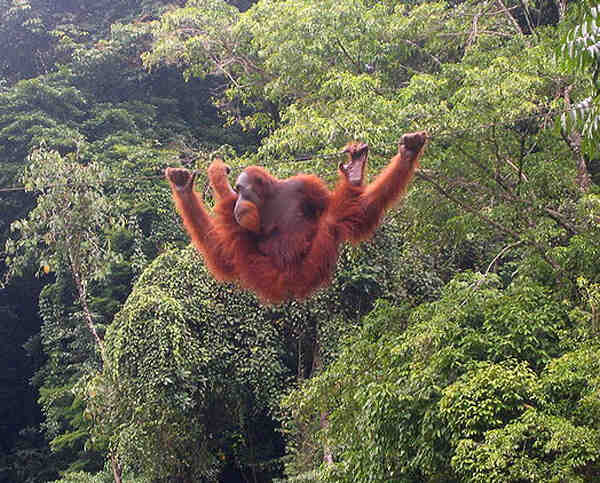
The Sumatran orangutan builds a nest in a tree, flattens nearby branches and vines, and covers them with branches to form a nest that can only be lived in for one night. A new nest is built the next night. It has the slowest reproduction rate of all mammal species, with an interval of about 8 years between births. The gestation period is 235-270 days, and each litter has one baby. The newborn weighs about 1.6 kg. It can grasp things reflexively at birth and can grasp the mother's long hair to suck milk. The baby lives with the mother for about 5 years before living independently. The life span of wild orangutans is about 45 years, which is longer than the reproductive cycle of other primates. Female orangutans produce no more than three offspring in their lifetime.
The United Nations Environment Programme World Conservation Monitoring Center published an investigation report stating that due to urban expansion, deforestation and disease invasion, many large apes, including two Sumatran orangutans, two African gorillas and African bonobos, will become extinct in a generation (about 25 years). For example, after 50 years, there may be only 250 Sumatran orangutans left. They will inevitably go extinct. The report shows that the most critically endangered are the Sumatran orangutans living in Indonesia, whose numbers will be reduced by half in five years. There are only about 7,300 of these orangutans left, hiding in the jungles of Aceh in northern Sumatra. This is a very small number for the entire population.
Listed in the World Conservation Union (IUCN) ver.: 2008 Endangered Species - Critically Endangered (CR).
Listed in Appendix I of the Washington Convention on International Trade in Endangered Species of Wild Fauna and Flora (CITES) Appendix I in the 2019 edition.
The World Conservation Union (IUCN) announced in Hawaii that the Sumatran orangutan is classified as critically endangered.
Protect wild animals and eliminate game.
Maintaining ecological balance is everyone's responsibility!

